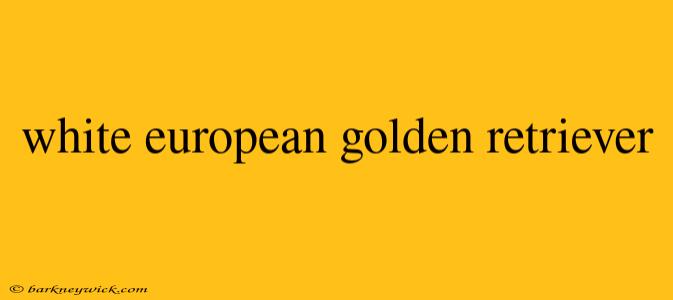The Golden Retriever: A European Legacy of Loyalty and Beauty
My Golden Boy and the European Connection
My golden retriever, Finn, is the heart of our family. He’s a goofy, affectionate bundle of sunshine, always ready for a cuddle or a game of fetch. But what I love most about him is his lineage. Finn is a European Golden Retriever, and his bloodline traces back to the Scottish Highlands, the birthplace of the breed. This heritage is more than just a cool fact – it tells a story about the breed’s history, temperament, and even its appearance.
European Goldens: A Look Back in Time
The Golden Retriever as we know it today was developed in Scotland by Lord Tweedmouth, a hunting enthusiast, in the mid-19th century. He wanted a loyal and capable retriever with a gentle nature. He achieved this by crossing yellow Retrievers with Tweed Water Spaniels and other breeds.
While the Golden Retriever quickly gained popularity in Britain, its popularity spread to other European countries. In Germany, for instance, breeders focused on developing a larger, more robust Golden Retriever, known as the "Kontinental" or "Continental" Golden Retriever. These European lines have maintained strong connections to the breed's original purpose, focusing on workability, health, and character.
European Goldens: Distinct Traits
European Golden Retrievers are generally characterized by:
- Stronger Build: They often have a slightly more robust frame than their American counterparts, with broader chests and thicker bones.
- Darker Coat: European Goldens tend to have darker coats, ranging from rich golden to mahogany shades, while American Goldens often have lighter, creamier tones.
- Stronger Instincts: Their hunting heritage is more evident, with a strong desire to please and work, making them ideal for activities like hunting, agility, and obedience.
Beyond the Breed Standard: A Focus on Temperament
But it’s not just physical attributes that set European Goldens apart. While looks are important, the true beauty of the breed lies in their unwavering loyalty, intelligence, and gentle nature.
My Finn embodies this perfectly. He’s intelligent and quick to learn, eager to please, and incredibly loving. These qualities are a testament to the breeding practices of dedicated European breeders who prioritize temperament and character.
Choosing a European Golden Retriever: What to Consider
If you’re considering getting a Golden Retriever, exploring European lines might be a perfect fit. Here are some things to keep in mind:
- Research Reputable Breeders: Look for breeders who prioritize health, temperament, and breed standards. Check for certifications like the Kennel Club (UK) or the European Golden Retriever Club.
- Understand the Temperament: European Goldens, while generally friendly, may be more demanding of mental and physical stimulation due to their working heritage. Be prepared to provide plenty of training, exercise, and interaction.
- Prepare for Potential Differences: European Goldens might have different coat textures or coloration than American lines.
A Legacy of Loyalty: Finn and the Future of Golden Retrievers
Finn has brought immeasurable joy to our lives. He embodies the best of what makes the European Golden Retriever so special: his intelligence, loyalty, and gentle nature.
As the breed evolves, the influence of European lines is significant. Their focus on workability and health, coupled with their commitment to the breed's original purpose, ensures the future of the Golden Retriever remains one of resilience, loyalty, and undeniable charm.
If you're looking for a dog that’s both beautiful and brilliant, one that’s a true companion and a loyal friend, consider the European Golden Retriever. They're a testament to the legacy of the breed and a reminder of the timeless bond between humans and dogs.
